Nathan Susanj
SharpZO: Hybrid Sharpness-Aware Vision Language Model Prompt Tuning via Forward-Only Passes
Jun 26, 2025Abstract:Fine-tuning vision language models (VLMs) has achieved remarkable performance across various downstream tasks; yet, it requires access to model gradients through backpropagation (BP), making them unsuitable for memory-constrained, inference-only edge devices. To address this limitation, previous work has explored various BP-free fine-tuning methods. However, these approaches often rely on high-variance evolutionary strategies (ES) or zeroth-order (ZO) optimization, and often fail to achieve satisfactory performance. In this paper, we propose a hybrid Sharpness-aware Zeroth-order optimization (SharpZO) approach, specifically designed to enhance the performance of ZO VLM fine-tuning via a sharpness-aware warm-up training. SharpZO features a two-stage optimization process: a sharpness-aware ES stage that globally explores and smooths the loss landscape to construct a strong initialization, followed by a fine-grained local search via sparse ZO optimization. The entire optimization relies solely on forward passes. Detailed theoretical analysis and extensive experiments on CLIP models demonstrate that SharpZO significantly improves accuracy and convergence speed, achieving up to 7% average gain over state-of-the-art forward-only methods.
Context-Driven Dynamic Pruning for Large Speech Foundation Models
May 24, 2025Abstract:Speech foundation models achieve strong generalization across languages and acoustic conditions, but require significant computational resources for inference. In the context of speech foundation models, pruning techniques have been studied that dynamically optimize model structures based on the target audio leveraging external context. In this work, we extend this line of research and propose context-driven dynamic pruning, a technique that optimizes the model computation depending on the context between different input frames and additional context during inference. We employ the Open Whisper-style Speech Model (OWSM) and incorporate speaker embeddings, acoustic event embeddings, and language information as additional context. By incorporating the speaker embedding, our method achieves a reduction of 56.7 GFLOPs while improving BLEU scores by a relative 25.7% compared to the fully fine-tuned OWSM model.
Saten: Sparse Augmented Tensor Networks for Post-Training Compression of Large Language Models
May 20, 2025Abstract:The efficient implementation of large language models (LLMs) is crucial for deployment on resource-constrained devices. Low-rank tensor compression techniques, such as tensor-train (TT) networks, have been widely studied for over-parameterized neural networks. However, their applications to compress pre-trained large language models (LLMs) for downstream tasks (post-training) remains challenging due to the high-rank nature of pre-trained LLMs and the lack of access to pretraining data. In this study, we investigate low-rank tensorized LLMs during fine-tuning and propose sparse augmented tensor networks (Saten) to enhance their performance. The proposed Saten framework enables full model compression. Experimental results demonstrate that Saten enhances both accuracy and compression efficiency in tensorized language models, achieving state-of-the-art performance.
Wanda++: Pruning Large Language Models via Regional Gradients
Mar 06, 2025Abstract:Large Language Models (LLMs) pruning seeks to remove unimportant weights for inference speedup with minimal performance impact. However, existing methods often suffer from performance loss without full-model sparsity-aware fine-tuning. This paper presents Wanda++, a novel pruning framework that outperforms the state-of-the-art methods by utilizing decoder-block-level \textbf{regional} gradients. Specifically, Wanda++ improves the pruning score with regional gradients for the first time and proposes an efficient regional optimization method to minimize pruning-induced output discrepancies between the dense and sparse decoder output. Notably, Wanda++ improves perplexity by up to 32\% over Wanda in the language modeling task and generalizes effectively to downstream tasks. Further experiments indicate our proposed method is orthogonal to sparsity-aware fine-tuning, where Wanda++ can be combined with LoRA fine-tuning to achieve a similar perplexity improvement as the Wanda method. The proposed method is lightweight, pruning a 7B LLaMA model in under 10 minutes on a single NVIDIA H100 GPU.
MaZO: Masked Zeroth-Order Optimization for Multi-Task Fine-Tuning of Large Language Models
Feb 17, 2025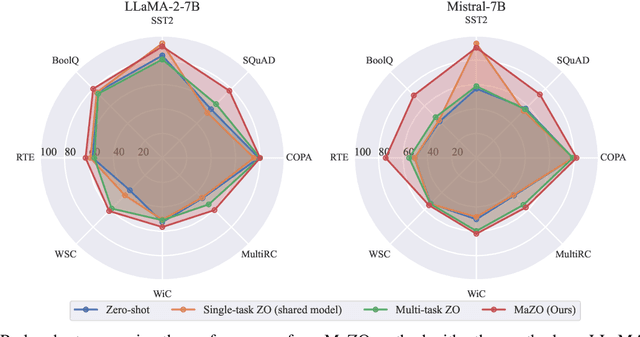
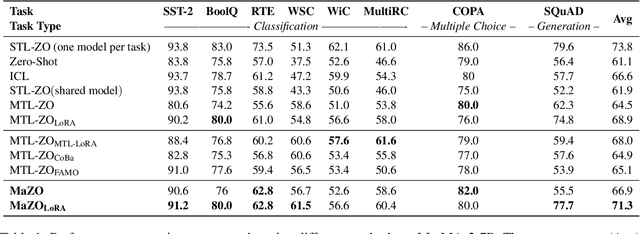


Abstract:Large language models have demonstrated exceptional capabilities across diverse tasks, but their fine-tuning demands significant memory, posing challenges for resource-constrained environments. Zeroth-order (ZO) optimization provides a memory-efficient alternative by eliminating the need for backpropagation. However, ZO optimization suffers from high gradient variance, and prior research has largely focused on single-task learning, leaving its application to multi-task learning unexplored. Multi-task learning is crucial for leveraging shared knowledge across tasks to improve generalization, yet it introduces unique challenges under ZO settings, such as amplified gradient variance and collinearity. In this paper, we present MaZO, the first framework specifically designed for multi-task LLM fine-tuning under ZO optimization. MaZO tackles these challenges at the parameter level through two key innovations: a weight importance metric to identify critical parameters and a multi-task weight update mask to selectively update these parameters, reducing the dimensionality of the parameter space and mitigating task conflicts. Experiments demonstrate that MaZO achieves state-of-the-art performance, surpassing even multi-task learning methods designed for first-order optimization.
Accelerator-Aware Training for Transducer-Based Speech Recognition
May 12, 2023



Abstract:Machine learning model weights and activations are represented in full-precision during training. This leads to performance degradation in runtime when deployed on neural network accelerator (NNA) chips, which leverage highly parallelized fixed-point arithmetic to improve runtime memory and latency. In this work, we replicate the NNA operators during the training phase, accounting for the degradation due to low-precision inference on the NNA in back-propagation. Our proposed method efficiently emulates NNA operations, thus foregoing the need to transfer quantization error-prone data to the Central Processing Unit (CPU), ultimately reducing the user perceived latency (UPL). We apply our approach to Recurrent Neural Network-Transducer (RNN-T), an attractive architecture for on-device streaming speech recognition tasks. We train and evaluate models on 270K hours of English data and show a 5-7% improvement in engine latency while saving up to 10% relative degradation in WER.
* Accepted to SLT 2022
Sub-8-bit quantization for on-device speech recognition: a regularization-free approach
Oct 17, 2022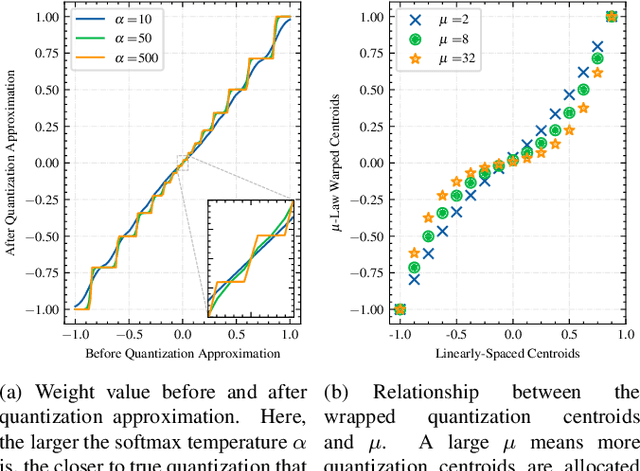
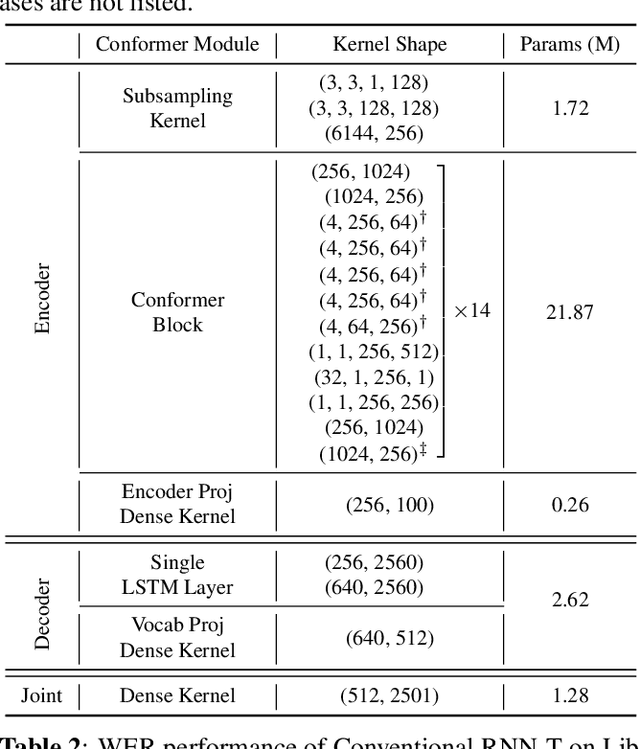

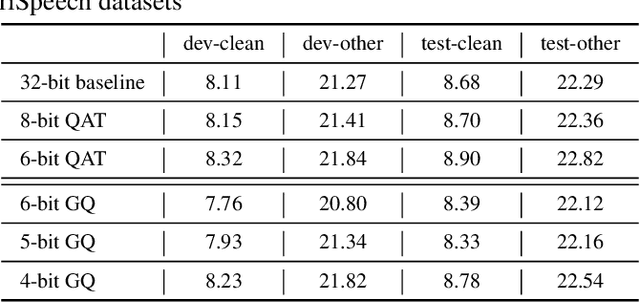
Abstract:For on-device automatic speech recognition (ASR), quantization aware training (QAT) is ubiquitous to achieve the trade-off between model predictive performance and efficiency. Among existing QAT methods, one major drawback is that the quantization centroids have to be predetermined and fixed. To overcome this limitation, we introduce a regularization-free, "soft-to-hard" compression mechanism with self-adjustable centroids in a mu-Law constrained space, resulting in a simpler yet more versatile quantization scheme, called General Quantizer (GQ). We apply GQ to ASR tasks using Recurrent Neural Network Transducer (RNN-T) and Conformer architectures on both LibriSpeech and de-identified far-field datasets. Without accuracy degradation, GQ can compress both RNN-T and Conformer into sub-8-bit, and for some RNN-T layers, to 1-bit for fast and accurate inference. We observe a 30.73% memory footprint saving and 31.75% user-perceived latency reduction compared to 8-bit QAT via physical device benchmarking.
ConvRNN-T: Convolutional Augmented Recurrent Neural Network Transducers for Streaming Speech Recognition
Sep 29, 2022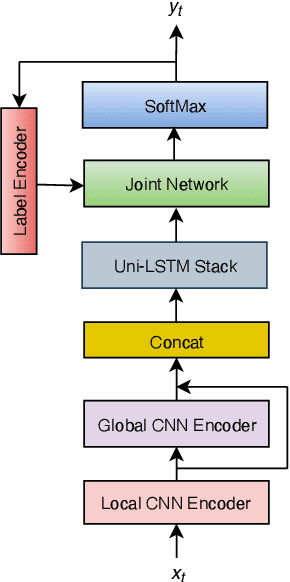
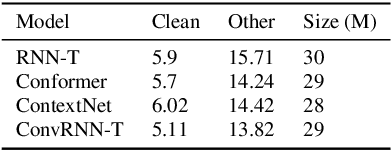
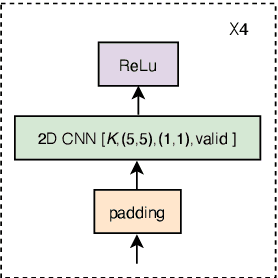
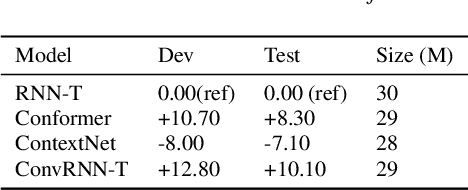
Abstract:The recurrent neural network transducer (RNN-T) is a prominent streaming end-to-end (E2E) ASR technology. In RNN-T, the acoustic encoder commonly consists of stacks of LSTMs. Very recently, as an alternative to LSTM layers, the Conformer architecture was introduced where the encoder of RNN-T is replaced with a modified Transformer encoder composed of convolutional layers at the frontend and between attention layers. In this paper, we introduce a new streaming ASR model, Convolutional Augmented Recurrent Neural Network Transducers (ConvRNN-T) in which we augment the LSTM-based RNN-T with a novel convolutional frontend consisting of local and global context CNN encoders. ConvRNN-T takes advantage of causal 1-D convolutional layers, squeeze-and-excitation, dilation, and residual blocks to provide both global and local audio context representation to LSTM layers. We show ConvRNN-T outperforms RNN-T, Conformer, and ContextNet on Librispeech and in-house data. In addition, ConvRNN-T offers less computational complexity compared to Conformer. ConvRNN-T's superior accuracy along with its low footprint make it a promising candidate for on-device streaming ASR technologies.
Sub-8-Bit Quantization Aware Training for 8-Bit Neural Network Accelerator with On-Device Speech Recognition
Jun 30, 2022
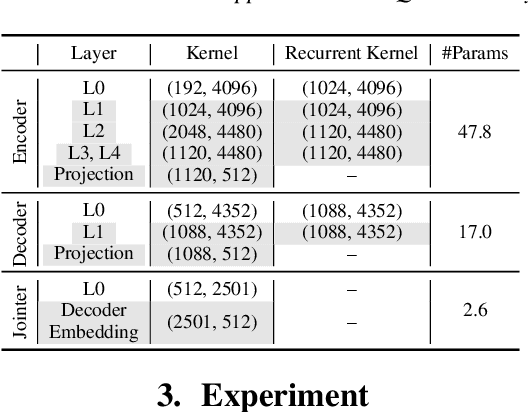
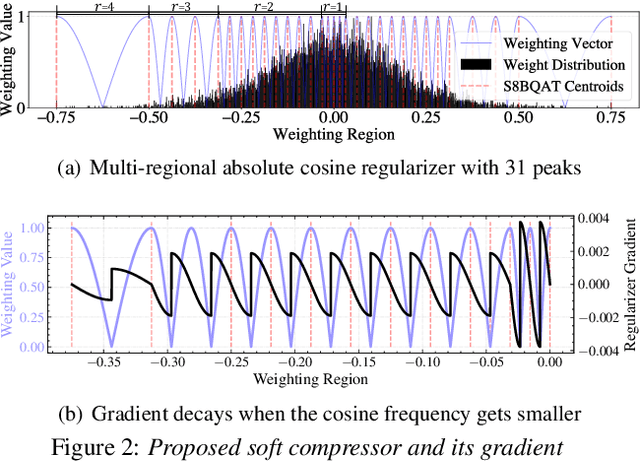
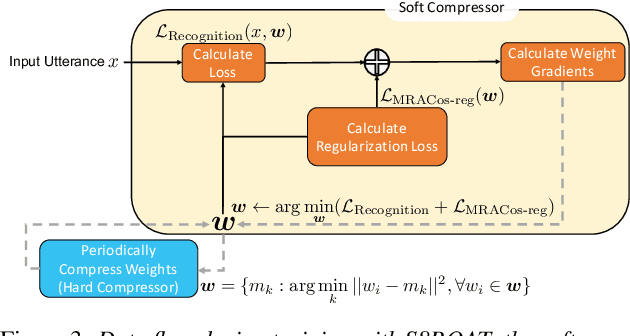
Abstract:We present a novel sub-8-bit quantization-aware training (S8BQAT) scheme for 8-bit neural network accelerators. Our method is inspired from Lloyd-Max compression theory with practical adaptations for a feasible computational overhead during training. With the quantization centroids derived from a 32-bit baseline, we augment training loss with a Multi-Regional Absolute Cosine (MRACos) regularizer that aggregates weights towards their nearest centroid, effectively acting as a pseudo compressor. Additionally, a periodically invoked hard compressor is introduced to improve the convergence rate by emulating runtime model weight quantization. We apply S8BQAT on speech recognition tasks using Recurrent Neural NetworkTransducer (RNN-T) architecture. With S8BQAT, we are able to increase the model parameter size to reduce the word error rate by 4-16% relatively, while still improving latency by 5%.
A neural prosody encoder for end-ro-end dialogue act classification
May 11, 2022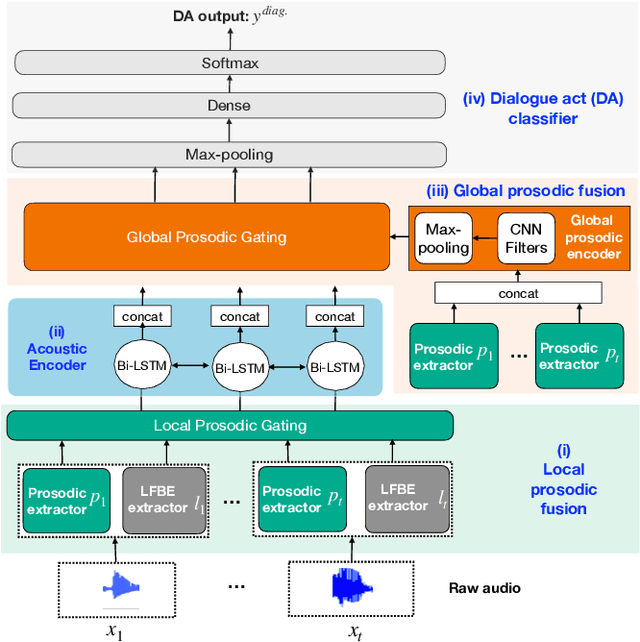

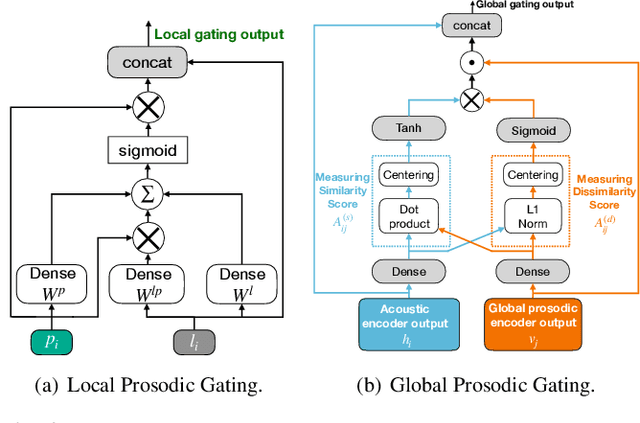

Abstract:Dialogue act classification (DAC) is a critical task for spoken language understanding in dialogue systems. Prosodic features such as energy and pitch have been shown to be useful for DAC. Despite their importance, little research has explored neural approaches to integrate prosodic features into end-to-end (E2E) DAC models which infer dialogue acts directly from audio signals. In this work, we propose an E2E neural architecture that takes into account the need for characterizing prosodic phenomena co-occurring at different levels inside an utterance. A novel part of this architecture is a learnable gating mechanism that assesses the importance of prosodic features and selectively retains core information necessary for E2E DAC. Our proposed model improves DAC accuracy by 1.07% absolute across three publicly available benchmark datasets.
 Add to Chrome
Add to Chrome Add to Firefox
Add to Firefox Add to Edge
Add to Edge